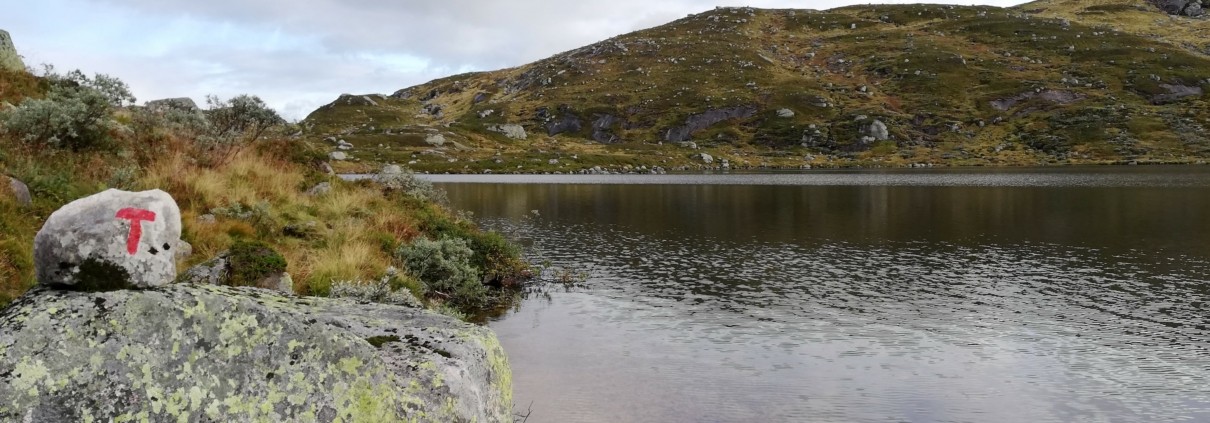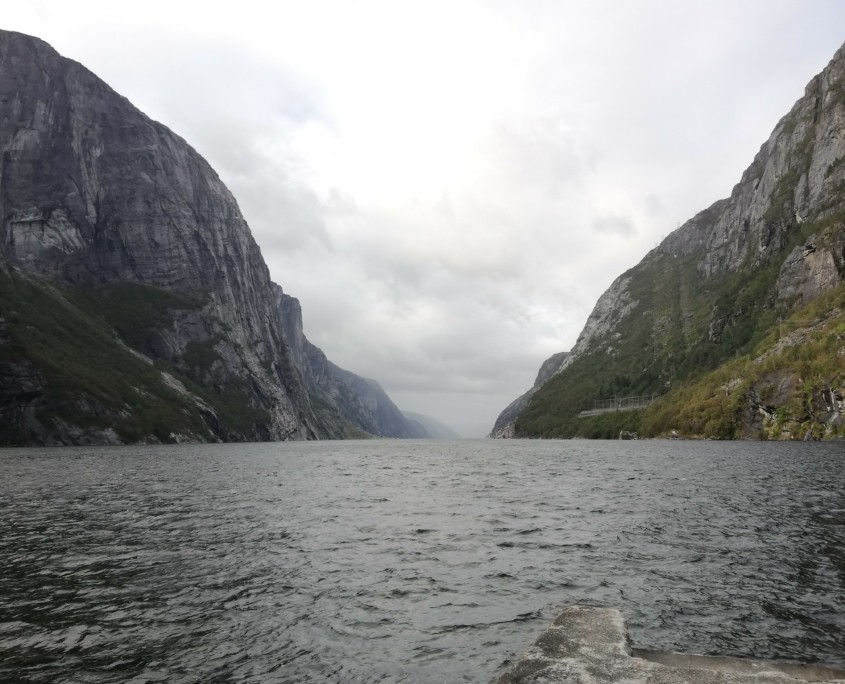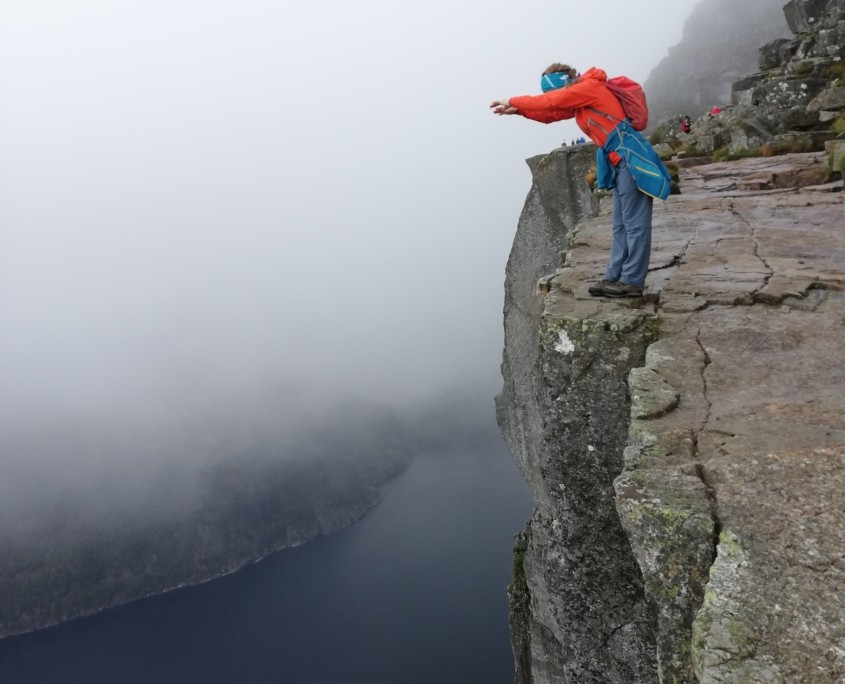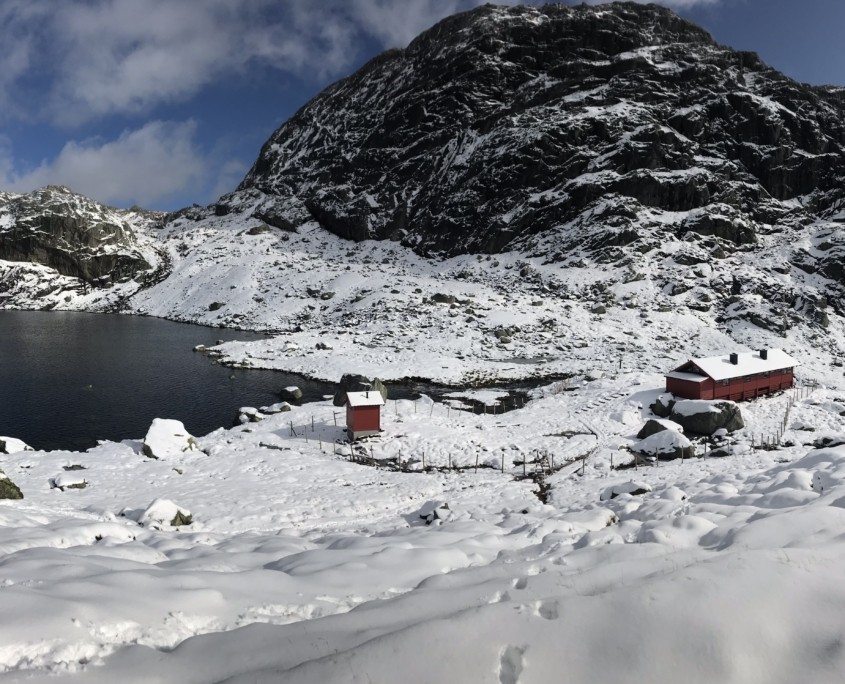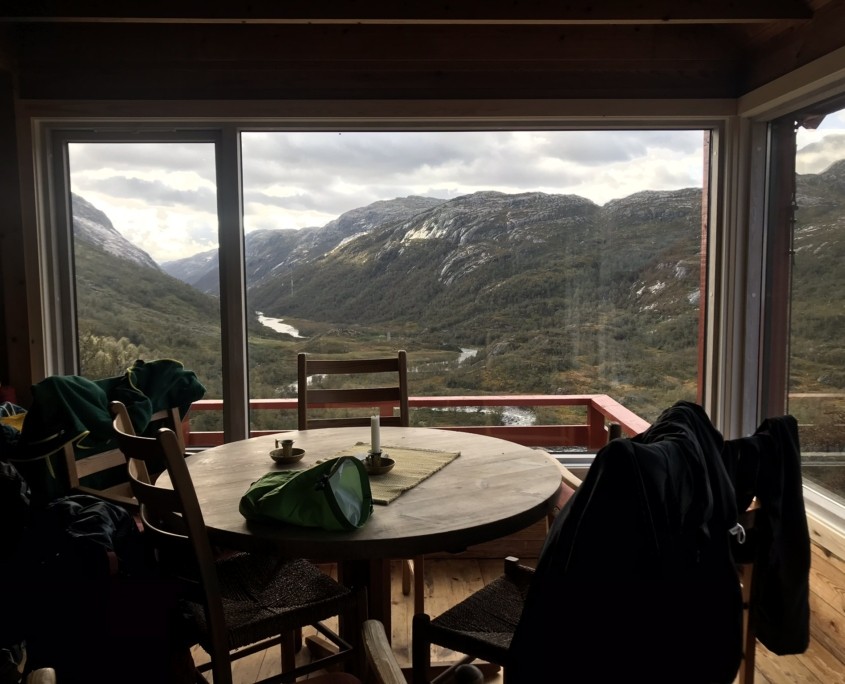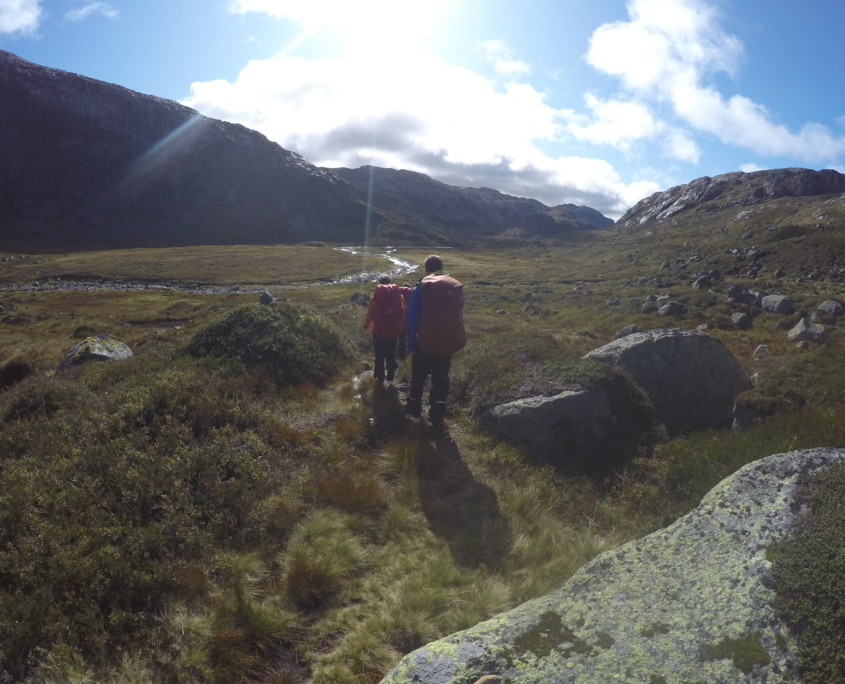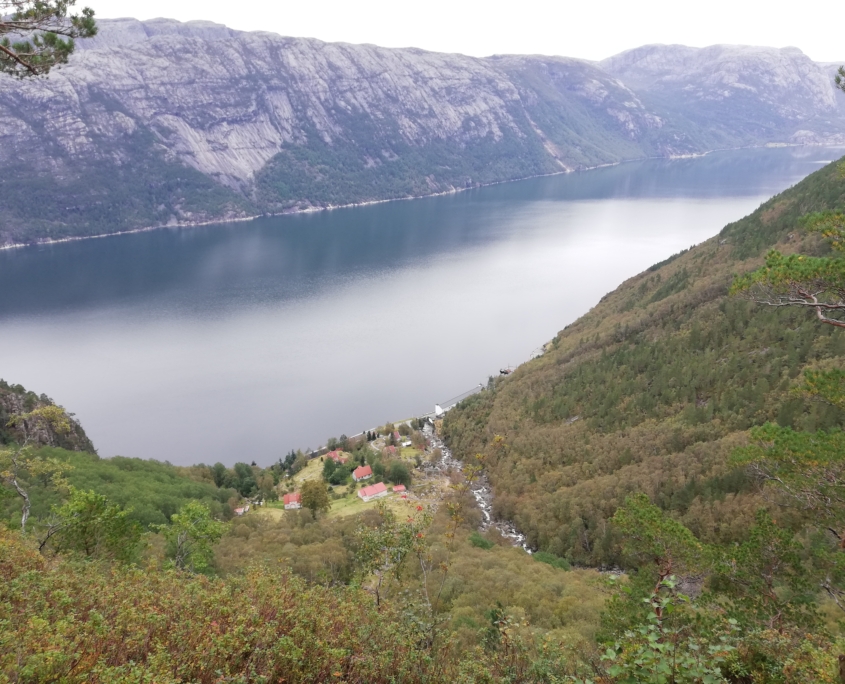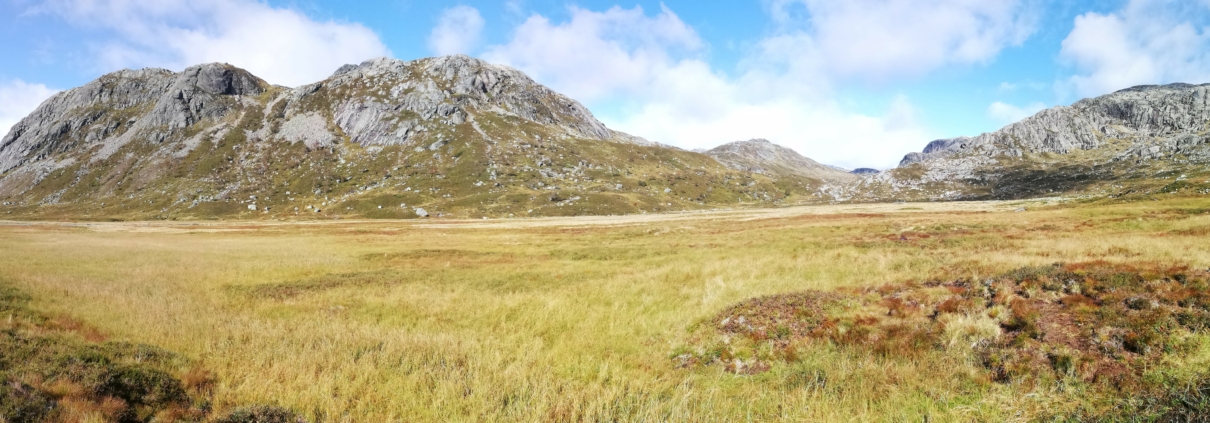AN ADVENTURE THROUGH THE WILDERNESS OF NORWAY
A travel story by Maria Stan and Lyubomir Hristov
The path to Preikestolen is crowded with tourists, but we pass them like a breeze. Preikestolen (also named Pulpit Rock) is a jagged square of rock protruding over the Lysefjord. It is shrouded in fog as we come upon it, and we can’t tell standing on its edge how far below us the water is. Quickly we turn back from this detour; further back down the tourist trail we find a little dirt path wandering off into the woods. Along the center of the path a signposts warns us: “Stop! This is not the way to the Preikestolen!”. An unnecessary sign, we think – the path is so steep and narrow that most tourists completely ignore it. Yet, for us it is only the beginning of a long journey.
So, where are we heading to? The plan was set up two weeks ago, while analyzing a map with hiking trails in Southern Norway. We were searching for the one route that would give us the most of Norway: a fjord, high cliffs, but also forests and mountains. And so we decided: After a night’s stay at Stavanger, a city on the south-western coast of the country, we would go from hut to hut along the Lysefjord and over mountainous terrain as far east as our feet could carry us in 7 days’ time. The huts, owned by Den Norske Turistforening (“The Norwegian Trekking Association”), would represent a crucial part. They would provide refuge after a long day of hiking. We decided to not carry a tent – despite having the right to camp anywhere in Norway through the “Allemannsretten”, the soft soil and the frequent precipitations make setting up a tent quite a tough challenge. Huts, on the other hand, are really practical: not only is there a fireplace inside to warm up the rooms and the beds (and to dry the clothes after a rainy day), but they are also equipped with various kitchen utensils, pots, plates… everything one would need to prepare all sorts of meals. This is all based on trust – most huts are not staffed and unlocked, so anybody who uses them should pay through a mobile app or through a payment form for their stay and the goods they used from the hut (firewood, food supplies etc).
Preparations were wrapped up: we borrowed some useful equipment from BUA – a facility that lends outdoor equipment for free all over Norway – bought hopefully enough food for the trip, and purchased bus tickets to Stavanger and from there to Preikestolen Fjellstue, our starting point.
View over Lysefjord from Lysebotn
Fog on Preikestolen
And now here we are, following this twisted path marked with the red “T” (“tur” – tour in Norwegian) along the northern wall of Lysefjord, through sparse pine and birch forests. Soon we realize our pace is becoming hindered; wet roots make slipping easy and crossing small streams becomes a frequent task. To our right we see yet another cloud billowing into the fjord… And the rain follows us until we reach the first hut. However hard the day has been, all four of us are smiling as we sit around the carved wooden table, enjoying a warm, rewarding dinner, and thinking about what an adventure we have gotten ourselves into.
The next two days are marked by continuous rain, and the trek does not get easier. Apart from the fact that our clothes are completely soaked, harsh winds blow through our jackets, numbing our bodies with cold. And then there are the river crossings… We are not even halfway to the next hut on the third day when we come to an impasse. The path continues gingerly on the other side of a wide river. To our dismay, the rope which had been strung over the river to ease the passage is torn in two. We are looking for another way to reach the opposite shore where we don’t have to go knee-deep through the dangerously fast flowing water. Unfortunately we don’t find it, which leaves wading through the river our only option.
As we emerge out of the valley, we finally see the entire mysterious appearance of the fjord, with distant waterfalls that plunge hundreds of meters into the abyss and whose greate wisps of vapour combine with the cloud layer above. Eventually the last kilometer comes and we stumble into Lysebotn, the town at the end of the fjord and our destination for this long and hard day.
It took us three days to come this far, one more than initially planned. The extreme weather makes it too dangerous to wander further east, as streams are flooding down the steep paths. We quickly find the alternative solution: We would just keep hiking for another couple of days around the fjord, this time on the southern side, then take a ferry back to Stavanger. And, in addition to that, we would take a rest day to regain our strength, dry our clothes and raise our morale. Three days of continuously hiking through rain have been more than enough, for both our bodies and our minds.
Langavatn hut covered with snow
Blåfjellenden – a hut with a magnificent view
On the fifth day of the tour we are dropped off at Øygardstølen, the starting point for the hike to the famous Kjeragbolten. It is foggy when we get to the parking lot and we know already what to expect just a couple of steps after starting to walk: snow! The granite slabs up to Kjerag are completely covered with fresh snow. Everything is either snowy white or dark and black, we find stairs and rock cairns only from this contrasting silhouette. Markings, our trusted red T’s, are not visible. Once we emerge onto the top of the mountainous plateau, the winds turn against us, trying to push us off our feet. And then we finally see it, the Kjeragbolten, a lonely boulder wedged between two rocks at the end of a crevice. Given the snowy conditions, we refrain from taking a classic picture on this 5 cubic-meter stone and continue briskly on our way.
After all that rain in the past days, we end up enjoying today: no mud, no rivers to cross… and finally some sunshine! The clouds part and the sun shine brightly towards the end of the day as we reach the next hut at the foot of a hill.
Surprisingly, this is the first day when we meet some other hikers, all of them taken aback by the snow. It is interesting how Norwegians get very talkative in the mountains, because in the cities they seem quite distant. On the long and empty road it is always a pleasure to share a few words with other travelers. We will also not forget how generously two other hikers once offered us to get some of their food.
Dream landscape on the path between Langavatn and Blåfjellenden
Flørli on the shore of Lysefjord
The last two days of the trip are pure pleasure: the sun is shining, and the snow melts quickly, making the path visible again. It feels like a reward, after all the struggle with the weather during the previous days. We pass through beautiful large valleys and next to lakes with clear water, fully enjoying every moment and feeling so happy to be here. This is what we have come for, after all! We finish our hike in Flørli, a small village by the fjord, known for the longest wooden stairway in the world (4444 steps!).
Early next morning we embark on the ferry to Stavanger. It is foggy, like in the first day, when we were up on Preikestolen… which seems so far back. Some cliffs sometimes peek through the fog as the ferry speeds past and we would get a glimpse of rocky shores and mountainous forests. We smile. Those are some wonderful places that we experienced.
This trip taught us to appreciate whatever is given to us – be it sunny weather, three days of rain, a snowstorm or 70 km/h winds. Despite the many moments of despair, when our bodies were soaking wet and freezing in the pouring rain, the experience made us stronger. It was something special, even beautiful. It feels like only now are we really getting to know Norway.

